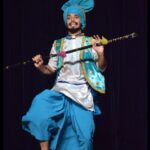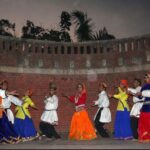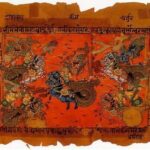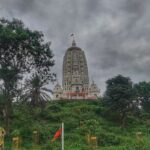Hi there! I’m a folk dance researcher and writer from Himachal Pradesh. Today, I want to talk about the amazing traditional dances of this beautiful region. Himachal Pradesh has a rich variety of folk dances that have been passed down through generations and are still popular today.
These vibrant, energetic performances showcase the culture and customs of the area in an incredibly exciting way. Let’s explore some of these wonderful dances together and learn more about their origins and traditions!
Kinnauri Natti
 Kinnauri Natti is a traditional folk dance of Himachal Pradesh. It is an integral part of the culture and heritage that has been passed down from generations to generations.
Kinnauri Natti is a traditional folk dance of Himachal Pradesh. It is an integral part of the culture and heritage that has been passed down from generations to generations.
This spectacular display of energy, color and grace mesmerizes onlookers every time it’s performed. The movements in Kinnauri Natti involve a mix of Laath dance moves as well as Jhora dance steps.
The dancers are dressed in vibrant colors and move in perfect synchronization with each other while the drums provide a lively beat for their performance. This captivating form of artistry has become increasingly popular over the years, drawing travelers from all around to experience its beauty firsthand.
From grand events to small gatherings, Kinnauri Natti offers an unforgettable visual extravaganza no matter where it’s performed. Moving on from here, Bhangra takes center stage next!
Bhangra
 I’m a folk dance researcher from Himachal Pradesh, and one of the most popular dances here is Bhangra. This energetic form of dance originated in Punjab but has now spread to other parts of Northern India, including my home state.
I’m a folk dance researcher from Himachal Pradesh, and one of the most popular dances here is Bhangra. This energetic form of dance originated in Punjab but has now spread to other parts of Northern India, including my home state.
Bhangra involves lots of rhythmic clapping, arm movements, and spins; it’s often associated with joyous occasions like weddings and festivals. The music that accompanies Bhangra includes both traditional Punjabi tunes as well as Bollywood-style remixes.
The lyrics are usually upbeat and fun, celebrating life events or praising God. Some popular Bhangra songs include ‘Challa’ by Rabbi Shergill and ‘Gur Nalo Ishq Mitha’ by Malkit Singh. Dandiya Raas is another popular dance style in Himachal Pradesh which involves two people dancing around each other with sticks in their hands.
It requires skillful footwork and intricate hand gestures set to the beat of drums and traditional Gujarati Garba music. As I continue exploring the various folk dances of my region, let me turn now to Jhoomar – an ancient artform originating in Rajasthan…
Jhoomar
The Bhangra of Himachal Pradesh is a vibrant and celebratory folk dance performed to traditional Punjabi music. It has become increasingly popular in recent years, with over 2 million people taking part in the annual International Bhangra Festival held in Chandigarh every year.
Jhoomar is another form of folk dance from Himachal Pradesh, though it differs considerably from Bhangra. While both dances are traditionally accompanied by drums and other instruments such as dhols, tashas and jhanjaras, Jhoomar requires more intricate footwork than the comparatively simpler steps of Bhangra.
The dress code for this type of dance usually consists of bright salwar kameez suits reflecting the culture and heritage of Himachal Pradesh:
Traditional musical accompaniment often features stringed instruments like sitars or sarods which produce soothingly melodic sounds that give rise to graceful movements among dancers. This style of dancing also makes use of props such as swords or sticks while swirling colorful scarves add an additional layer of gracefulness to each performance.
Nati is one of the oldest forms of folk dance originating in the valleys of Himachal Pradesh; its origins can be traced back centuries ago when kings would perform Nati during special occasions. Dancers typically wear elaborate costumes consisting mostly of red hues alongside pankhas (hand fans).
Similar to Jhoomar, nati performances require synchronization between multiple performers who move together in circular patterns and execute complex hand gestures with poise throughout their routine.
Nati
 Nati is an ancient folk dance of Himachal Pradesh. This traditional style of dance has been a part of the culture for centuries and continues to be enjoyed by locals today. It consists mainly of dances such as Dangi Dance, Chuhu Dance, etc., that are performed in different festivals and occasions during the year.
Nati is an ancient folk dance of Himachal Pradesh. This traditional style of dance has been a part of the culture for centuries and continues to be enjoyed by locals today. It consists mainly of dances such as Dangi Dance, Chuhu Dance, etc., that are performed in different festivals and occasions during the year.
Nati’s unique steps involve balancing skills and intricate footwork which require precision and practice to perfect. The costumes used by dancers usually feature bright colors like red, yellow, green, blue and orange. The music involved in Nati performances is composed using several instruments including drums, flutes and dholaks (a type of drum).
In addition to this, singers provide vocals that complement the rhythm created by these instruments. Songs accompanying the performance often talk about tales from folklore or local legends. These songs evoke emotion among both performers and spectators alike through their meaningful lyrics. All these elements make Nati one of the most mesmerizing forms of art found in Himachal Pradesh.
Apart from being aesthetically pleasing, participation in Nati also provides physical benefits to its practitioners; it strengthens muscles while improving balance and concentration levels at the same time. Such are the positive impacts that this vibrant form of entertainment brings with itself! With all that said, let’s move on to exploring Luddi and Gidha – two other important types of folk dancing styles native to our state.
Luddi And Gidha
 Folk dancing in Himachal Pradesh is an exciting and vibrant experience that everyone should witness. The two most popular dances of the region are Luddi and Gidha.
Folk dancing in Himachal Pradesh is an exciting and vibrant experience that everyone should witness. The two most popular dances of the region are Luddi and Gidha.
These dances have been passed down through generations, preserving the culture of this beautiful state. The origins of these folk dances can be traced back to centuries ago, when they were used as a form of celebration during weddings or other important occasions.
From then on they have evolved into the two distinct styles we know today. Luddi is a fast-paced dance performed by groups in sync with each other while Gidha is more graceful, traditionally danced only by women accompanied by men playing drums and singing traditional songs like Chambey di ragni and thumri dance.
These two distinctive forms of folk dancing bring color and joy to any event – whether it’s for a wedding or simply for entertainment! Both involve intricate footwork, hand movements, clapping, twirling and much more to create a mesmerizing effect that leaves audiences spellbound.
With 4/4 timing and energetic rhythms, no one can resist joining in the fun!
Frequently Asked Questions
Q1. What Are The Traditional Costumes Worn For Folk Dances In Himachal Pradesh?
A. In Himachal Pradesh, traditional costumes for folk dances are unique and vibrant. Men typically wear a dhoti or kurta pajama made of fine muslin or cotton, with an embroidered waistcoat over it.
The women also tend to wear a colorful salwar-kameez suit decorated with intricate needlework. Additionally, feminine attire often includes large hair jewelry, jutis (traditional footwear), bangles, earrings and necklaces to complete the look.
All these components combined make up the beautiful outfits that bring life to any folk dance in Himachal Pradesh!
Q2. How Do Folk Dances Of Himachal Pradesh Differ From Other Indian States?
A. Folk dances from Himachal Pradesh differ from that of other Indian states in many ways. As a folk dance researcher and writer, I’ve seen these differences first-hand.
The costumes worn by the dancers are indicative of the social implications of their culture – bright colors, intricate embroidery and detailed designs give insight into the local customs and beliefs.
From region to region within Himachal Pradesh, there’s a noticeable difference in the music and movements used for each type of dance, as well as its cultural significance.
Overall, it’s fascinating to witness such an array of diversity across India when it comes to traditional folk dancing!
Q3. What Is The History Of Folk Dances In Himachal Pradesh?
A. The history of folk dances in Himachal Pradesh can be traced back centuries, with the state’s people utilizing and adapting traditional dance styles, rituals and customs according to their own distinct culture.
From classical forms such as Kathak and Bhangra to tribal dances like Cholskit Dhami, each region showcases its unique form of expression through these ancestral art forms.
Many of these dances are performed at festivals or special occasions, telling stories that have been passed down from generation to generation. It is truly remarkable how vibrant and alive this tradition remains today!
Q4. What Are The Musical Instruments Used For Folk Dances In Himachal Pradesh?
A. As a researcher and writer of folk dances in Himachal Pradesh, I can tell you that traditional songs and folk music are integral to the region’s culture.
In fact, these types of musical instruments have been used for centuries in various folk dance performances. There is an amazing range of different drums, flutes, stringed instruments, as well as other percussion items such as bells or cymbals which combine to bring forth the beat and melody of each unique performance.
It truly is mesmerizing to watch how all these elements come together to create something completely captivating!
Q5. Are There Any Restrictions On Performing Folk Dances In Himachal Pradesh?
A. When it comes to folk dances in Himachal Pradesh, there are some restrictions depending on the traditional roles and dance styles.
For example, men and women have traditionally been expected to take part in separate dances that focus on different aspects of culture. Some types of dances may even be exclusive to one gender or another.
It’s important for anyone wishing to perform these dances to understand the cultural context before doing so.
Conclusion
Folk dances in Himachal Pradesh are a source of great joy and pride for its people. The colourful costumes, the melodious music, and the intricate steps all come together to create an experience like no other.
Every time I witness these vibrant performances, it conjures up images that transport me right back into my own childhood when we used to perform folk dances with friends during festivals. It’s truly a magical feeling!
In this way, the traditional folk dances of Himachal Pradesh have become an integral part of our culture, bringing us closer to each other and reminding us what unites us as one community.
Read our latest blog about: Should College Athletes Be Paid Essay – 3209 Words
- Sri Lalitha Ashtottara Shatanamavali in Telugu – శ్రీ లలితాష్టోత్తరశతనామావళిః - April 11, 2024
- Sri Durga Kavacham in Telugu – శ్రీ దుర్గా దేవి కవచం - April 10, 2024
- Shivananda Lahari in Telugu – శివానందలహరీ - April 9, 2024


